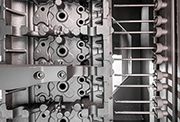E-Archive
Articles
in Vol. 20 - September Issue - Year 2019
Automotive At Its Most Intricate: New Machine Launches For Complex Internal Blasting

A thin nozzle for the internal airblasting of narrow channels

A robot arm picks up a workpiece for blasting in Wheelabrator’s IDS machine

An outside view of the blast chamber – compressed air is fed to arrays of blast nozzles

A row of blast nozzles is getting ready to dive into the narrow cavities of a complex cylinder head
Combustion engines are getting lighter and lighter, reducing fuel consumption and emissions. The results are ever-more-complex engine block and cylinder head designs with intricate internal surfaces. To clean these reliably after casting, shot blast experts at Wheelabrator have been working with vehicle manufacturers to develop blast processes that match these new complexities. The result: the IDS shot blast machine for automotive applications. A sophisticated, modular machine type that blasts inside the most complex workpieces.
For many years now, the internal areas of key automotive engine components have been inaccessible to external blast machines and, consequently, internal airblasting has become more and more important, constantly stretching the limits of existing equipment.
Developed and refined over time in close conjunction with a major German car and heavy-duty vehicle manufacturer, the Wheelabrator IDS airblast machine meets this evolving challenge. The machine features a modular robot design that allows it to be tightly integrated and automated.
The machine’s blast nozzles drive deep into channels and other cavities to reach internal surfaces down to a minimum diameter of 11mm.
The robot picks each part from a roller conveyor and holds it into the blast chamber, where it moves and turns the part to expose it to the blast nozzles.
After blasting, the robot arm gently sways the part to let any abrasive and debris run off, before removing it from the chamber and placing it back on the conveyor.
The modular cell design allows the easy extension of the machine with a row of robot arms working to a blast chamber each. This ensures production increases can be accommodated, while the lance-mounted exchangeable blast nozzles can be adapted and upgraded to keep pace with changing process needs.
As any equipment designed for the automotive industry, the IDS is optimised for maximum uptime, with manganese liners inside the blast chamber reducing wear, and clever abrasive logistics ensuring a constantly perfect abrasive mix.
Bernhard Seuffert from Wheelabrator explains: "Since the early 2000s, when we first installed a predecessor to the IDS at this prestigious German automotive manufacturer, internal blast requirements have evolved rapidly. Pretty much every year since 2010, we have partnered with the customer to develop a new evolution of this machine type. This involved completely new machines for new production lines, as well as upgrading or expanding existing IDS machines. Over time, a flexible, modular IDS system has emerged from what was initially a highly customised solution. It is suited to applications that require the internal blasting of bores and water jacket apertures of cylinder heads, crank cases, engine blocks and similar complex castings."
For Information:
DISA Industrie AG (Wheelabrator)
Kasernenstrasse 1, 8184 Bachenbülach, Switzerland
Tel. +41.44.815 4000
Fax +41.44.815 4001
E-mail: zurich@wheelabratorgroup.com
www.wheelabratorgroup.com




























